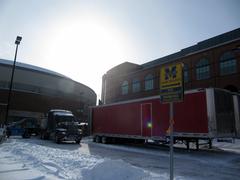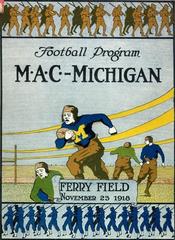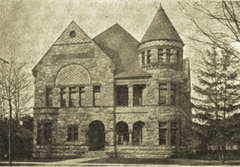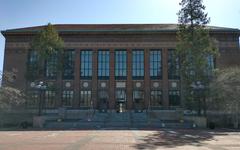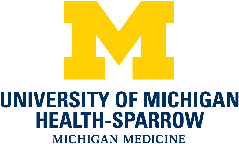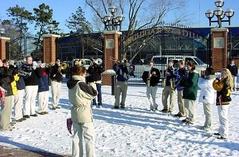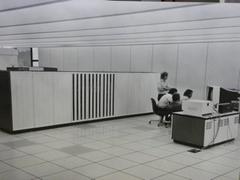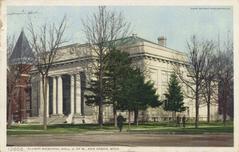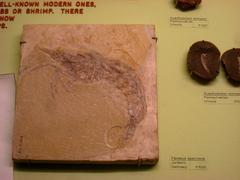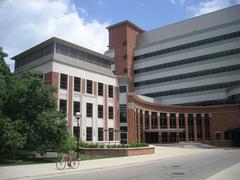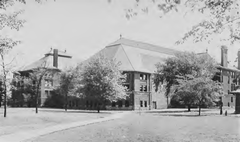Great Lakes Environmental Research Laboratory
Great Lakes Environmental Research Laboratory (GLERL) Visiting Guide: Ann Arbor Historical Site
Date: 14/06/2025
Introduction: Discovering GLERL’s Role in Great Lakes Stewardship
The Great Lakes Environmental Research Laboratory (GLERL), located in Ann Arbor, Michigan, is a leading research institution dedicated to the science and protection of the Great Lakes—the world’s largest surface freshwater system. Since its establishment in 1974 by the National Oceanic and Atmospheric Administration (NOAA), GLERL has addressed environmental challenges such as pollution, habitat loss, invasive species, and, more recently, climate change. Situated near the University of Michigan, GLERL leverages academic partnerships and interdisciplinary collaboration to advance research, shape policy, and engage the public.
GLERL combines technological innovation with scientific expertise, utilizing real-time monitoring, remote sensing, and sophisticated ecological modeling to understand and forecast emerging threats like harmful algal blooms (HABs). While it primarily functions as a research facility with limited public access, GLERL regularly opens its doors through special programs, outreach events, and educational initiatives, providing the public with avenues to connect with Great Lakes science. This guide offers a comprehensive overview of GLERL’s history, research evolution, public engagement opportunities, and practical visitor information for those interested in environmental science and regional history (NOAA GLERL, CIGLR, Planet Detroit).
Table of Contents
- Founding and Early Development
- Research Evolution and Scientific Impact
- Institutional Partnerships
- Key Achievements
- Visitor Information: Location, Hours, and Access
- Educational and Fellowship Programs
- Visitor Experience: Facilities, Amenities, and Engagement
- Seasonal Planning and Nearby Attractions
- Frequently Asked Questions (FAQ)
- Summary and Final Tips
- Sources
Founding and Early Development
GLERL was established in 1974 as a response to mounting environmental crises in the Great Lakes, including severe pollution, habitat degradation, and declining fish populations. Its creation was influenced by pivotal events like the 1969 Cuyahoga River fire and the environmental movement of the early 1970s. The laboratory quickly became a central hub for scientific research and environmental monitoring, developing partnerships with the University of Michigan and other regional institutions to foster collaborative efforts in resource management (Planet Detroit).
Research Evolution and Scientific Impact
Initially focused on water quality and fisheries, GLERL’s research scope has grown to encompass ecosystem health, invasive species, climate change, and harmful algal blooms. The laboratory has played a major role in Lake Erie’s recovery from eutrophication, supporting nutrient management strategies that improved water quality throughout the 1980s (Planet Detroit). Today, GLERL utilizes advanced technologies such as:
- Real-time monitoring buoys
- Remote sensing and satellite data
- Ecological and climate modeling
These capabilities enable the laboratory to provide forecasts and warnings about threats like HABs and to inform adaptive management practices across the Great Lakes region.
Institutional Partnerships
GLERL’s collaborative spirit is exemplified by its partnerships with federal, state, tribal, and academic organizations. The Cooperative Institute for Great Lakes Research (CIGLR), based at the University of Michigan, is a flagship partnership supporting joint research, workforce development, and public outreach (CIGLR). GLERL also works with the USGS Great Lakes Science Center (GLSC) and other agencies to address regional ecological challenges (USGS GLSC).
Key Achievements
GLERL’s contributions have shaped environmental policy and public health protection:
- Harmful Algal Bloom Forecasting: GLERL operates the region’s primary HAB forecasting system, which provides real-time data and was instrumental in preventing a recurrence of the 2014 Toledo water crisis (Planet Detroit).
- Nutrient Management: Research by GLERL has informed strategies to reduce phosphorus runoff—a key driver of HABs.
- Climate Change Adaptation: Studies on temperature trends, ice cover, and weather extremes guide adaptive management.
- Invasive Species Monitoring: Early detection and response to invasives like zebra mussels and round gobies protect the Great Lakes’ ecological balance.
Visitor Information: Location, Hours, and Access
Address: 2205 Commonwealth Blvd, Ann Arbor, MI 48105
- Location: Near the University of Michigan’s North Campus Research Complex, accessible by car, bus (TheRide), and within reach of Detroit Metropolitan Wayne County Airport.
- Visiting Hours: Generally open Monday–Friday, 8:00 AM–5:00 PM. Public tours, open houses, and group visits are by appointment or during special events. Always check event listings in advance (NOAA GLERL).
- Tickets: Admission is free; special events may require advance registration.
Some areas of the laboratory are restricted as it is a federal research facility. Visitors are encouraged to contact GLERL ahead of time to confirm access, tour availability, and event schedules.
Educational and Fellowship Programs
GLERL is a hub for STEM education and workforce development, notably through the Great Lakes Summer Fellows Program, which offers immersive research experiences for undergraduate and graduate students. Fellows collaborate with GLERL and CIGLR scientists on projects like climate modeling, hydrology, and environmental data analysis, and gain valuable mentorship and networking opportunities (Freshwater Science Job Posting).
Application Tips:
- Apply online by February deadline.
- Submit a resume, transcripts, statement of interest, and letters of recommendation.
- Diverse candidates, especially those underrepresented in STEM, are strongly encouraged to apply.
- Hybrid and remote participation options are available.
Visitor Experience: Facilities, Amenities, and Engagement
Facilities
- Modern laboratories and meeting spaces designed for research and collaboration.
- Interactive displays on topics such as HABs, invasive species, and autonomous monitoring.
- Accessible entrances, restrooms, ramps, and elevators.
Visitor Amenities
- Free on-site parking (may be limited during peak times).
- Public transit access via TheRide.
- Wheelchair accessibility throughout the facility.
- Limited on-site dining; numerous options available in Ann Arbor.
Engagement Opportunities
- Attend open houses, seminars, or public outreach events (check schedules on CIGLR and NOAA GLERL).
- Participate in hands-on demonstrations and science activities during special events.
- Connect with scientists and explore career paths in environmental research.
Photography
- Permitted in public spaces and during events.
- Restrictions apply in sensitive or secure research areas—always ask before photographing.
Safety
- Check in at the main entrance and wear a visitor badge.
- Follow all safety guidelines and staff instructions.
- Children must be supervised at all times.
Seasonal Planning and Nearby Attractions
Best Times to Visit: Spring and fall are optimal, with most public programs and mild weather. Winter events, such as the “Winter Grab” sampling campaign, offer unique experiences but may be subject to weather constraints (U-M SEAS News).
Nearby Attractions:
- University of Michigan Museum of Natural History
- Nichols Arboretum and Matthaei Botanical Gardens
- Downtown Ann Arbor’s shops, galleries, and restaurants
For broader regional exploration, consult the Great Lakes Information Network (GLIN) and local watershed education programs.
Frequently Asked Questions (FAQ)
Q: Is GLERL open to the public year-round?
A: GLERL does not offer routine open hours or tours. Public access is available during scheduled events or by appointment.
Q: Are there admission fees or ticket requirements?
A: Admission is free. Some events may require registration.
Q: Can I arrange a group or educational tour?
A: Yes, with advance notice and subject to availability—contact GLERL’s administrative office for details.
Q: Is the facility accessible for individuals with disabilities?
A: Yes, GLERL is fully accessible.
Q: Where can I find event schedules and updates?
A: Visit the GLERL and CIGLR websites.
Q: Is photography allowed?
A: Yes, in public areas unless otherwise posted.
Summary and Final Tips
The Great Lakes Environmental Research Laboratory is a cornerstone in freshwater science and regional stewardship. Its legacy of research, policy influence, and public engagement continues to shape the future of the Great Lakes. While not a traditional tourist site, GLERL offers meaningful engagement through outreach programs, fellowships, and special events. Prospective visitors, fellows, and science enthusiasts are encouraged to plan ahead, connect with staff, and explore Ann Arbor’s vibrant academic and historical offerings.
Stay informed by following NOAA GLERL, CIGLR, and related regional networks. Download the Audiala app for curated guides and event updates, and make your visit to Ann Arbor and GLERL memorable by immersing yourself in both science and local culture.
Sources
- Planet Detroit – Exploring the Great Lakes Environmental Research Laboratory (GLERL): History, Research, and Visitor Information
- CIGLR – Great Lakes Summer Fellows Program
- GLERL Official Website, NOAA
- Cooperative Institute for Great Lakes Research (CIGLR), University of Michigan
- USGS Great Lakes Science Center (GLSC)
- NOAA Education – Great Lakes Resources
- University of Michigan SEAS News
- Freshwater Science Job Posting – Great Lakes Summer Fellowships 2025
